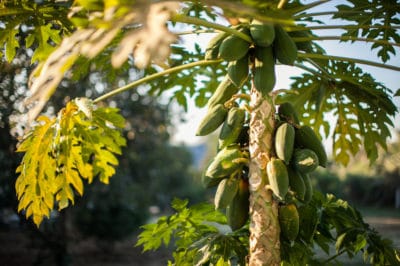Leading Papaya Producers
Of all the papaya grown in the world, India takes the lead in growing papaya. The second highest producer is Brazil, and then comes Indonesia, Nigeria, Mexico, Dominican Republic, Guatemala and Belize, Costa Rica and Ecuador. The U.S. only grows 0.1 percent of papaya production. In the U.S., the states that grow papayas are Hawaii, California, Texas and Florida.
Papaya Growing Climates
You might not know that papayas, which grow as tall as 30 foot trees, are herbs. These succulents grow in tropical and subtropical areas. They need temperatures from 70°(21.1°C) to 90°F (32.2°C), as well as over 40 inches of rain annually.
Papayas don’t tolerate freezing temperatures. They suffer severe damage, if the temperature gets below 31°F (-0.6°C). They also require full sun and well-drained, moist soil with neutral soil pH of 6.0 and 7.0.
Papayas only live for about four years, even in the best warm and humid climates. You can also plant papaya in USDA Hardiness zones 10 and 11, if you have irrigation, but your papayas may not survive more than two years.
Papaya Varieties
Most papayas are one of two varieties. Hawaiian papayas are small and Mexican papayas are large. The most common small varieties are solo cultivars:
- Rainbow – This is the most popular papaya variety, featuring golden yellow flesh.
- Kapoho – This papaya has dark yellow to light orange coloring. It tastes like a peachy melon.
- Sunrise – Sometimes called strawberry papaya, this is very sweet with red-orange flesh.
- Sun Up – This solo cultivar has red flesh.
- Golden – Although it’s named Solo Golden, this papaya has red flesh.
In Mexico, the most abundant large cultivar is Maradol, which features pink to red fruit with a very sweet flavor. Another Mexican cultivar with medium-sized fruit is Tai Nung. Its fruit is a bright salmon color and very sweet. The skin is yellow green with spots.
Papayas Grown in the U.S.
The following list describe which parts of the U.S. grow papayas. All of these states have the climate conditions that make growing papayas possible:
- Hawaii – Most of the papayas grown in Hawaii are from The Big Island. They’re grown all year but the hot, dry weather can cause papaya plants to become sterile. Hawaii exports 95 percent of the papayas grown in the U.S., according to the University of Florida Food and resource Economics Department.
- California – The growing season for papaya in California is from February to November. Because this is a short season for papayas, the fruit is small. Most of the papayas grown in California come from the San Joaquin Valley.
- Texas – If you live in Texas, expect your papayas to survive only about two years because of the cool weather and occasional freezing temperatures. Most papayas that do grow in Texas are from the lower Rio Grande Valley.
- Florida – The subtropical climate in Florida offers the best growing conditions for papayas in the continental U.S. You can grow them year round, if you live in Miami-Dade County. The most fruit production is during the summer and fall.
Fruit Production
If you take care of your papaya plants, giving them the required soil conditions, water and weather, then they’ll produce flowers within four months from planting. The fruit develops in seven to eleven months. The amount of fruit you’ll be able to harvest depends on the papaya variety you planted and your weather conditions. If the conditions are right, you can harvest 60 to 80 pounds of papaya from each tree yearly.
